 |
 |
 |
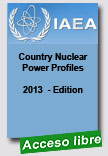 |
Country Nuclear Power Profiles - 2013 Edition
IAEA Non-serial Publications, 2013, s. p.
The Country Nuclear Power Profiles compile background information on the status and development of nuclear power programmes in Member States. The CNPP summarizes organizational and industrial aspects of nuclear power programs and provides information about the relevant legislative, regulatory, and international framework in each country. Its descriptive and statistical overview of the overall economic, energy, and electricity situation in each country and its nuclear |
power framework is intended to serve as an integrated source of key background information about nuclear power programs in the world. This 2013 edition, issued on CD-ROM and Web pages, contains updated country information for 51 countries.
Extraído de:
http://www-pub.iaea.org/books/IAEABooks/10620/Country-Nuclear-Power-Profiles-2013-Edition
|
 |
 |
WENRA Recommendation in connection with flaw indications found in Belgian reactors
Western European Nuclear Regulators Association (WENRA), Summer 2013, 5 p.
The reactor pressure vessels in every European nuclear power plant should be subjected to a standardised review to check for manufacturing flaws (hydrogen-induced forging defects).
The recommendation was issued by the Western European Nuclear Regulators Association (WENRA) to its members. |
Extraído de: http://www.wenra.org/media/filer_public/2013/08/30/wenra_media_
release_260813.pdf
|
 |
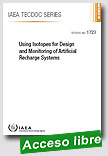 |
Using Isotopes for Design and Monitoring of Artificial Recharge Systems (ARS)
IAEA TECDOC, 2013, 74 p.
Isotopes are underutilized in AR and ASR projects, but are very powerful tools for: (1) planning projects; (2) monitoring and improving efficiency/optimization; and (3) understanding water quality aspects. The objective of this publication is to encourage greater use of isotope methods for AR and ASR projects by providing discussion and examples of the kinds of issues that isotopes can address.
|
This report discusses the use of a wide variety of stable isotope and radioactive isotopes for AR and ASR studies. It covers applications relevant to passive recharge approaches (e.g. ponded infiltration) as well as active approaches (direct pumping of water into an aquifer system). It is intended to be a resource not only for hydrologists, but also for water managers and policy makers who are interested in knowing how isotopes may be effectively used as part of AR and ASR investigations and monitoring programmes.
Extraído de: http://www-pub.iaea.org/MTCD/Publications/PDF/TE-1723_web.pdf |
 |
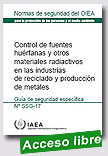 |
El objetivo primordial de la presente guía de seguridad es formular recomendaciones para los gobiernos y las autoridades nacionales, incluidos los órganos reguladores, sobre la aplicación de los Principios fundamentales de seguridad mediante el cumplimiento de los Requisitos de seguridad en relación con el control de los materiales radiactivos en la chatarra y los productos de metal. En las recomendaciones de |
la presente guía de seguridad se tienen en cuenta los principios básicos del Código de Conducta y las obligaciones que los Estados Partes puedan haber contraído en virtud de convenciones internacionales. No obstante, también se formulan recomendaciones generales para las industrias de reciclado y producción de metales sobre las disposiciones que se deberían adoptar para proteger a los trabajadores, los miembros de la población y el medio ambiente. Esta guía de seguridad se centra principalmente en el control de las fuentes huérfanas que podrían encontrarse en esas industrias. También se formulan recomendaciones sobre el control de otros materiales radiactivos que podrían introducirse en dichas industrias.
Extraído de: http://www-pub.iaea.org/MTCD/Publications/PDF/Pub1509s_web.pdf
|
 |
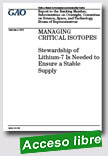 |
Managing Critical Isotopes: Stewardship of Lithium-7 Is Needed to Ensure a Stable Supply
Government Accountability Office (GAO-US), September 19, 2013, 31 p.
About 13 percent of our nation’s electricity is produced by pressurized water reactors that rely on lithium-7, an isotope of lithium produced and exported solely by China and Russia, for their safe operation. Lithium-7 is added to the water that cools the reactor core to prevent the cooling water from becoming acidic. Without the lithium-7, the cooling water’s acidity would
|
increase the rate of corrosion of pipes and other infrastructure—possibly causing them to fail. Utilities that operate the pressurized water reactors have experienced little difficulty obtaining lithium-7, but they may not be aware of all the risks of relying on two producers.
GAO was asked to review the supply and domestic demand for lithium-7 and how risks are being managed. This report examines (1) what is known about the supply and demand of lithium-7, (2) what federal agencies are responsible for managing supply risks, and (3) alternative options to mitigate a potential shortage. GAO reviewed documents and interviewed officials from DOE, NNSA, and NRC, in addition to industry representatives. This report is an unclassified version of a classified report also issued in September 2013.
GAO recommends that the Secretary of Energy ensure a stable future supply of lithium-7 by directing the Isotope Program to take on a stewardship role for lithium-7 by taking steps, including fully assessing risks and accurately determining domestic demand. DOE concurred with the recommendation.
Highlight
Extraído de:
http://www.gao.gov/products/GAO-13-71
|
 |
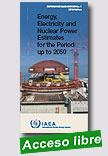 |
Energy, Electricity and Nuclear Power Estimates for the Period up to 2050 - 2013 Edition
IAEA Reference Data Series, 2013, 53 p.
Reference Data Series No. 1 (RDS-1) is an annual publication — currently in its thirty-third edition — containing estimates of energy, electricity and nuclear power trends up to the year 2050.
RDS-1 starts with a summary of the situation of nuclear power in IAEA Member States as of the end of 2012. The data on nuclear power presented in Tables 1 and 2 are based on actual statistical data collected by the IAEA’s Power Reactor Information System (PRIS). However, energy and electricity data for 2012 are estimated, as the latest information available from the United Nations Department of Economic and Social Affairs is for 2010 only. population data originate from the world population prospects (2010 revision), published by the population Division of the united Nations Department of Economic and Social Affairs. The 2012 values again are estimates.
|
Extraído de: http://www-pub.iaea.org/MTCD/Publications/PDF/RDS-1-33_web.pdf
|
 |
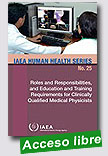
|
Roles and Responsibilities, and Education and Training Requirements for Clinically Qualified Medical Physicists
IAEA Human Health Series, 2013, 71 p.
This publication addresses the shortfall of well trained and clinically qualified medical physicists working in radiation medicine. The roles, responsibilities and clinical training requirements of medical physicists have not always been well defined or well understood by health care professionals, health authorities and regulatory agencies. To fill this gap, this publication provides recommendations for the academic education and clinical training of clinically qualified medical physicists, including recommendations for their accreditation certification and registration, along with continuous professional development. The goal is to establish criteria that support the harmonization of education and clinical training worldwide, as well as to promote the recognition of medical physics as a profession. |
Extraído de:
http://www-pub.iaea.org/books/IAEABooks/10437/Roles-and-Responsibilities-and-Education-and-Training-Requirements-for-Clinically-Qualified-Medical-Physicists
|
 |
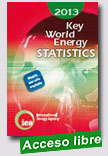 |
Key World Energy Statistics 2013
International Energy Agency (IEA), 2013, 82 p.
The IEA produced its first handy, pocket-sized summary of key energy data in 1997 and every year since then it has been more and more successful.
Key World Energy Statistics contains timely, clearly-presented data on supply, transformation and consumption of all major energy sources.
The interested businessman, journalist or student will have at his or her fingertips the annual Canadian production of coal, the
|
electricity consumption in Thailand, the price of diesel oil in Spain and thousands of other useful energy facts.
Extraído de: http://www.iea.org/publications/freepublications/publication/name,31287,en.html
|
 |
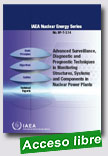 |
Advanced Surveillance, Diagnostic and Prognostic Techniques in Monitoring Structures, Systems and Components in Nuclear Power Plants
IAEA Nuclear Energy Series, 2013, 128 p.
This publication reports on the work and findings of an IAEA coordinated research project. The technologies discussed in this project are intended to establish the state of the art in surveillance, diagnostic and prognostic (SDP) technologies for equipment and process health monitoring in nuclear facilities. The participants also identified technology gaps and research
|
needs of the nuclear industry in the SDP area. The publication describes conventional SDP technologies as well as the latest tools, algorithms and techniques that have emerged over the past few years. These new tools have made it possible to identify problems earlier and with better resolution. The target audience of this publication is utility engineers, end users, researchers, managers and executives making decisions on implementation of the subject technologies in nuclear facilities, or determining the future direction of research and development in this area.
Extraído de: http://www-pub.iaea.org/books/IAEABooks/8763/Advanced-Surveillance-Diagnostic-and-Prognostic-Techniques-in-Monitoring-Structures-Systems-and-Components-in-Nuclear-Power-Plants
|
 |
|
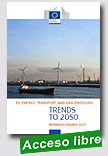
|
EU Energy, Transport and GHG Emissions - Trends to 2050
European Commission, December 2013, 173 p.
This report is an update and extension of the previous trend scenarios for development of energy systems taking account of transport and GHG emissions developments, such as the "European energy and transport - Trends to 2030" published in 2003 and its 2005, 2007 and 2009 updates. The purpose of this publication is present the new "EU Reference scenario 2013" ("Reference scenario" later in the text). This Reference scenario was finalized in July 2013. It focuses even more than previous
|
ones on the energy, transport and climate dimensions of EU developments and the various interactions among policies, inlcuding now specific sections on emission trends not related to energy. Its time horizon has been extended up to 2050. It reports for the first time on EU28 including Croatia. Moreover, the modelling process has included four rounds of consultation of Member States experts on Member States specific assumptions and draft modelling results. The responsibility for the results rests, however, with the authors of the scenario who were commissioned to do this work by Directorate General for Energy, Directorate General for Climate Action and Directorate General for Mobility and Transport.
Extraído de:
http://ec.europa.eu/energy/observatory/trends_2030/doc/trends_
to_2050_update_2013.pdf |
 |
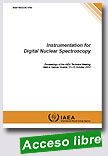 |
Instrumentation for Digital Nuclear Spectroscopy
IAEA TECDOC, 2013, 123 p.
This publication presents the results of an IAEA technical meeting on instrumentation for digital spectroscopy. The meeting provided a forum for discussion of ongoing issues regarding implementation of digital signal processing (DSP) in nuclear spectroscopy. Representatives from industry, research institutes and utilities presented recent experiences with DSP. New opportunities in high resolution spectrometry and the
|
advantages of their application in hand-held field instruments and in remote and unattended nuclear spectrometry systems were also discussed and reviewed.
Extraído de:
http://www-pub.iaea.org/books/IAEABooks/8852/Instrumentation-for-Digital-Nuclear-Spectroscopy |
 |
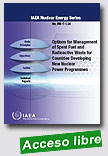 |
Options for Management of Spent Fuel and Radioactive Waste for Countries Developing New Nuclear Power Programmes
IAEA Nuclear Energy Serie, 2013, 54 p.
Countries embarking upon a nuclear power programme need to understand the importance of establishing an adequate radioactive waste and spent nuclear fuel management infrastructure. To assist in overcoming any challenges this might represent, this publication provides an overview of management practices in use in mature nuclear power
|
|
| |
|
|
|
| |
|
|
|
| |
|
